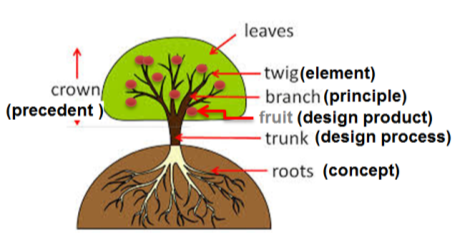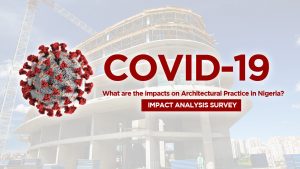A review and Current Issues:
A review of current issues examines the course content and processes. Emma of First in Architecture UK suggests a sequence on how to get started in architecture by looking at the essentials. Since this is a theoretical course, we examine the overarching ideologies in architecture. This is because these ideologies hinge on concepts and theories. Consequently, designs and structures express concepts and theories.
Getting to see the forest through the trees
To get a better understanding of these concepts and theories, let us distinguish between the two. Loosely defined, concepts are general ideas about a phenomenon, while theories are explanations of the phenomenon with some supporting evidence. To understand this visually, let us go back to the first lecture when we likened architecture to a mysterious forest. Let us look at a “prototypical” tree and examine it’s anatomy to explain the basic ideas behind design.

This is my impression of how design is processed. From the root or concepts to the fruits or product of design
A review of Current Issues through Architectural Concepts and Theories
According to Archisoup, “An architectural concept is an idea, notion, opinion, abstraction, philosophy, belief, inspiration, thought, intention, theory, image, plan, or hypothesis.” Concepts can be likened to the roots of the tree and are are processed through principles or branches.
A review and current issues of Architectural Principles: The branches of the trees
A principle is the enforced way an entity works, producing results. Principles are important components (branches) of the trees in the forest called architecture. As a result, without principles, every architectural tree would fail to exist. This is because you cannot have a tree without branches.
There are exceptions however. Banana trees, for instance don’t have branches, as technically they are herbaceous plants and not trees. Most cactus plants are plants as they do not have branches either.

A review and current issues of Architectural Theory: A tree in the Forest
If we can liken architecture as a mysterious forest, then Architectural Theory is one such tree in that forest. Just as principles are necessary for concepts to work, theories are equally important. This is because without theories, every architectural forest would fail to exist. For you cannot have a forest without trees.
Vitruvius, a review and current issues of the Architectural theorist
This is not a course exclusively on Architectural Theory though it is a theoretical course. To understand the context, we will look at the first Architectural theorist Marcus Vitruvius Pollio (c. 80–70 BC – after c. 15 BC), commonly known as Vitruvius, who was a Roman author, architect, civil engineer, and military engineer during the 1st century BC. His epic multi-volume work was titled De architectura or the Ten Books on Architecture. Vitruvius said, “Architecture is an imitation of nature. As birds and bees built their nests, so humans constructed housing from natural materials, which gave them shelter against the elements.”
From Vitruvius’ comparison of architecture to nature, you can better appreciate my analogies. For instance concepts are likened to roots, elements as twigs, principles as branches, designs as trunks, precedents as crowns and actual buildings (and structures) as fruits making up theories as trees in the forest of architecture.
Vitruvian Thoughts: Three important elements and more
Vitruvius considered three elements firmitas (integrity, or durability), utilitas (functionality or utility or convenience) and venustas (aesthetics or beauty). We should subject every design to satisfy these three elements to be successful. Vitruvius also gave a vivid written description of proportions which Leonardo da Vinci interpreted visually as the Vitruvian man.
Vitruvius and all the theorists that have followed him are very important because as theorists, they were able to make sense of this mysterious forest called architecture. Theorists achieved this by defining concepts, theories and other elements of architecture including proportion, symmetry, spatial considerations and all the things that make architecture a knowledge-based profession.
A Review and Current Theorists
The standard proportions for rooms date back to the architectural theorists Vitruvius, Palladio and Alberti[/caption]
After Vitruvius, there was Leon Battista Alberti and Andrea Palladio who wrote four books on Architecture during the Renaissance. And in more recent times Bruno Zevi, Charles Jencks, Rem Koolhaas, Kenneth Frampton and Peter Eisenman. In Africa, Nnamdi Elleh from the anglophone and and Masudi Alabi Fassassi from the francophone perspectives , have enjoyed international acclaim. Locally Cordelia Ososana on vernacular architecture, and our very own Zanzan Akaka Uji (informal housing settlements) and Bogda-Prucnal Ogunsote (modern Nigerian architecture) are relatively unsung heroes.
Let us explore Current Issues in Architectural Thought and Expression with the clearer understanding we have of architectural theories.
A Review of the aim of Current Issues
The aim of this course is to examine together with students the backgrounds on some of the epoch making events that have shaped our understanding and approach to architecture. The Emphasis of discussion is primarily on buildings and works of individual architects and firms. We will study iconic architects, buildings and movements that exert significant influences on the development of architecture in detail.
A Review of Course Methodology
This course will include short film documentaries, lectures, virtual class discussions, assigned readings for each class and campus building visits. We will use multimedia like YouTube, PowerPoint and other virtual tours of some of these buildings for a “first-hand look” and to evaluate for ourselves their significance or lack thereof. Students will analyse a building through drawings, text, bibliography and a 3-Dimensional model in a format ready for documentation and exhibition.
A Review of Course Assessments of current issues
Do weekly review and current issues assigned readings before class to provide you the student with background information for in-class discussion. Active student participation is mandatory. Students will attend each virtual class prepared with two thoughtful questions related to that day’s reading material. The questions should be submitted to the ARC students portal using the link prior to each class.
Class Attendance
Likewise we will upload attendance to the portal after every class. The final exam in this course will cover all materials discussed in class. There will be 2 individual projects and one group project that will be scheduled for exhibition. Class attendance counts toward the final grade and the Class representative will note any lateness of over 15 minutes.
A Great Benefit
Not only will a larger visual vocabulary enable students to communicate more effectively about design. Building vocabulary can also aid in developing their own design ideas in studio. Gaining an insight into iconic architectural works and movements in the past beyond the forms will give the students an opportunity to place their own design ideas within the architectural tradition. In other words they will be able to see both the forest and the trees!
Words of Advice from a sage
“The buildings of the past are studied so that the student will acquire from their significance and greatness a sense for genuine architectural values, and because their dependence upon a specific historical situation must awaken in him an understanding for the necessity of his own architectural achievement.” Mies van der Rohe
I also encourage you to go through the recommended readings; remember A CURRENT ARCHITECT IS A RELEVANT ARCHITECT!!!





What are the issues and models of integrated architectural design.
Other question is how can architects and urban designers change spaces into places
I believe you will discover the answer to these questions and answer them yourself as you progress in the current issues journey
This would really have a great impact, thanks very much for this ma.
We aim to please
This is a great exposition and I can’t wait to understand this study that will make me better and relevant in this field.
Great
How do we upload attendance ma?
Upload a screenshot of a list you generated based on those on the chat on Monday evenings. Or scan a hand written list of names. That can also serve.
Wow see architecture as trees
Yes!!!
Like these principles
Thank you
Great read! I look forward to our
deeper studies.
Great. I look forward to that as well.
I hope and pray that this course will expose me to this issues.
Oh it will. You however will need to deliberately engage the information and think through it all.
These are intriguing topics. Can’t wait to go further into discussion!
Neither can I
It’s a good one and I have gone through and find it interesting.
Good to know
Ma, please based on this “tree in the forest analogy”, is this course “Current Issues In Architectural Thoughts and Expressions” a tree in the forest too?
This course can be likened to a branch on one of the theoretical trees in the forest of Architecture
Wow can’t wait to learn more.
Great. Love your enthusiasm
This is interesting,looking forward to better understanding and learning
Looking forward to this too
Thank you ma.. Getting to understand architecture in terms of forest trees and branches
Theoretical courses are often abstract. I believe we can all relate to the tangible aspects of trees. They’re very beneficial to our existence, exchanging oxygen so vital to us with the carbon dioxide we exhale
I have never imagined architecture as a forest but this has actually impacted more knowledge to me it’s actually intruiging! Ma
Wonderful. May we all be successful foresters in the mysterious forest of Architecture
This is very intriguing
Thank you.
Thank you ma, I have acquired a better understanding on concept and principles
Understanding principles is progressive
Hmmn, this is interesting, so people started studying architecture a long time ago 80-70BC
I believe people have been studying Architecture since the existence of shelter, albeit informally
so great. looking forward to better understanding and learning
The desire to learn is mutual
Thank you I’m enjoying this
You’re welcome
Thanks ma’am, This would really have a great impact.
You’re welcome
I hope to learn more and understand more in the upcoming classes.
Happy to have you on this journey
Very interesting,I have a better understanding on the design processes
Great
Very helpful ma , can’t wait to learn more
Great. Let’s go
My perception of the system of architecture and its nature has become so much clearer!!
Could we suppose that some “trees” have intertwined branches?
Absolutely. Think of some of your theoretical courses for instance…
So interesting to know that
That’s good
This’s a real nice eye opener, and I’m more interested than ever.
Good to know
Can’t wait to explore this forest called architecture
Welcome and happy trails
I’m looking forward to learn what would be taught in this course it seems to be a course that would broaden my scope of architecture
Thank you. Looking forward to the journey
Architecture is truly a knowledge based profession. A successful design cannot be produced without sufficient information
Absolutely. Thank you for your insights